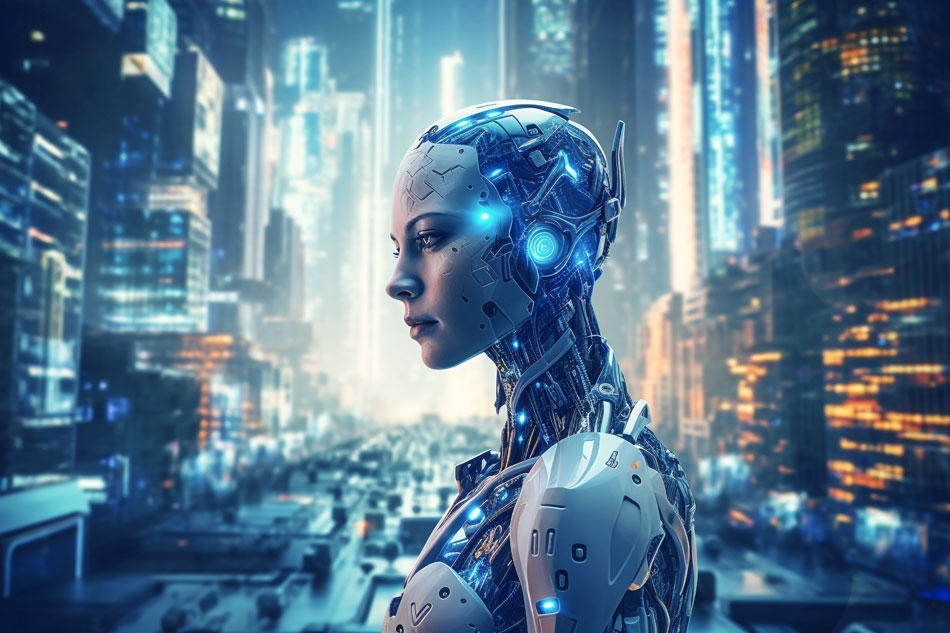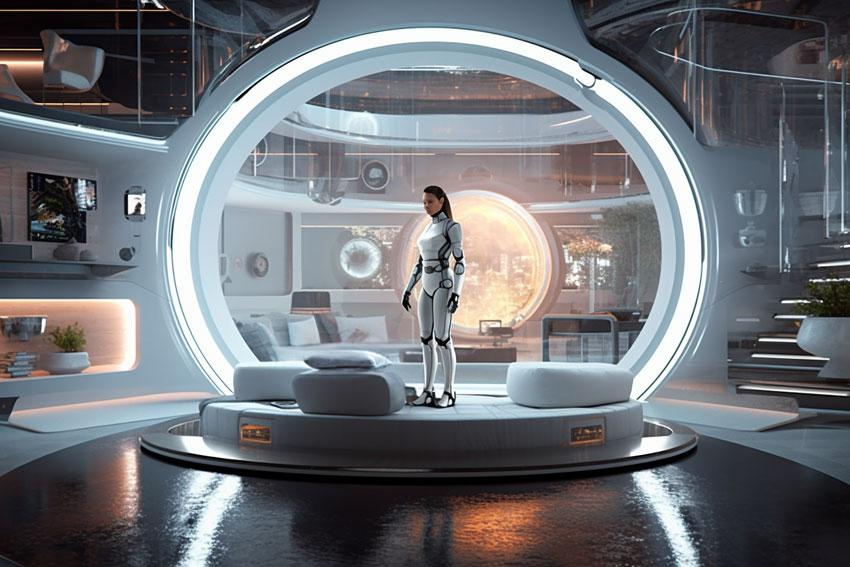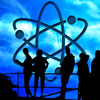The Future Of Neuro-Tech
 by Hugo de Garis
by Hugo de Garis
My name is Professor Hugo de Garis. I’m the head of a research group which designs and builds “artificial brains,” a field that I have largely pioneered. But I’m more than just a researcher and scientist — I’m also a social critic with a political and ethical conscience. I am very worried that in the second half of our new century, the consequences of the kind of work that I do may have such a negative impact upon humanity that I truly fear for the future.
You may ask, “Well, if you are so concerned about the negative impact of your work on humanity, why don’t you just stop it and do something else?” The truth is, I feel that I’m constructing something that may become rather godlike in future decades (although I probably won’t live to see it). The prospect of building godlike creatures fills me with a sense of religious awe that goes to the very depth of my soul and motivates me powerfully to continue, despite the possible horrible negative consequences.
I feel quite “schizophrenic” about this. On the one hand I really want to build these artificial brains and to make them as smart as they can be. I see this as a magnificent goal for humanity to pursue, and I will be discussing this at length in this book (see link below). On the other hand, I am terrified at how bleak are some of the scenarios that may ensue if brain building becomes “too successful,” meaning that the artificial brains end up becoming a lot more intelligent than the biological brains we carry around in our skulls. I will be discussing this too at length in this book.
Let me be more specific. As a professional brain building researcher and former theoretical physicist, I feel I am in a position to see more clearly than most the potential of 21st century technologies to generate “massively intelligent” machines. By “massively intelligent” I mean the creation of artificial brains which may end up being smarter than human brains by not just a factor of two or even ten times, but by a factor of trillions of trillions of trillions of times, i.e. truly godlike. Since such gargantuan numbers may sound more science fiction like to you than any possible future science, the third chapter of this book will explain the basic principles of those 21st century technologies that I believe will allow humanity, if it chooses, to build these godlike machines. I will try to persuade you that it is not science fiction, and that strong reasons exist to compel humanity to believe in these astronomically large numbers. I will present these technologies in as simple and as clear a way as I can, so that you do not need to be a “rocket scientist” (as the Americans say, i.e. someone very smart) to understand them. The basic ideas can be understood by almost anyone who is prepared to give this study a little effort.
All these fabulous 21st century technologies will permit the building of godlike massively intelligent machines. Probably a host of ethical, philosophical, and political questions will occur to you. The prospect of humanity building these godlike machines raises vast and hugely important questions.
One of the great technological economic trends of our recent history has been that of “Moore’s law,” which states that the computational capacities (e.g. electronic component densities, electronic signal processing speeds, etc) of integrated circuits or “chips,” have been doubling every year or two. This trend has remained valid since Gordon Moore, one of the founders of the Intel microprocessor manufacturing company, first formulated it in 1965. If you keep multiplying a number by 2 many times over, you will soon end up with a huge number. For example, 2 times 2 times 2 times 2 … (ten times) equals 1024. If you do it 20 times you get 1048576, i.e. over a million. If you do it 30 times, you get a billion, by 40 times you get a trillion, etc. Moore’s law has remained valid for the past four decades, so that the size of the doublings recently has become truly massive. I speak of “massive Moore doublings.”
Moore’s law is a consequence of the shrinking of the size of electronic circuits on chips, so that the distance that electrons (the elementary particles whose flow in an electronic circuit is what constitutes the electrical current) have to travel between two electronic components, (for example two transistors), is reduced. According to Einstein, the fastest speed at which anything can move is the speed of light (about 300,000 kms/sec) and this is a constant of nature that electronic currents have to respect. If one shortens the distance between two electronic components, then an electronic signal between them (i.e. the flow of electrons between them) has less distance to travel, and hence takes less time to traverse that distance (at the constant speed of light).
A huge effort over the past few decades has been devoted by the chip manufacturing companies into making electronic circuits smaller, and hence denser, so that they function faster. The faster a microprocessor chip functions, the more economically attractive it is. If you are the CEO of a chip manufacturing company and your competitor down the road in California’s “Silicon Valley” brings a rival chip onto the market that is 30% faster than yours and six months ahead of you, then your company will probably go out of business. The market share of the rival company will increase significantly, because everyone wants a faster computer. Hence, for decades, electronic circuitry has become smaller and thus faster.
How much longer can Moore’s law remain valid? If it does so until 2020, then the size of the electronic components in mass memory chips will be such that it will be possible to store a single bit of information on a single atom. (A “bit” is a “binary digit,” a 0 or a 1, that computers use to represent numbers and symbols to perform their calculations.) So how many atoms (and hence how many stored bits) are there in a human sized object, such as an apple? The answer is astonishing — a trillion trillion atoms (bits), i.e. a 1 followed by 24 zeros, or a million million million million.
Are you beginning to get an inkling for why I believe that massively intelligent machines could become trillions of trillions of times smarter than we are later this century?
Not only is it likely that 21st century technology will be storing a bit of information on a single atom, it will be using a new kind of computing called “quantum computing,” which is radically different from the garden variety or “classical computing” that humanity used in the 20th century. The principles of quantum computing will likely be that technology that will form the basis of the computers of the near and longer term future.
The essential feature of quantum computing can however be mentioned here. It is as follows. If one uses a string of N bits (called a “register” in computer science, e.g. 001011101111010) in some form of computing operation (it doesn’t matter for the moment what the operation is) it will take a certain amount of time using “classical computing.” However in the same amount of time, using “quantum computing” techniques, one can often perform 2N such operations. (2N means 2 multiplied by 2 multiplied by 2 … (N times)). As N becomes large, 2N becomes astronomically large. The potential of quantum computing is thus hugely superior to classical computing. Since Moore’s law is likely to take us to the atomic scale, where the laws of physics called “quantum mechanics” need to be applied, humanity will be forced to compute quantum mechanically, hence the enormous theoretical and experimental effort in the past few years to understand and build “quantum computers.”
Quantum computing still has many conceptual and practical problems that need to be solved before quantum computers are sold to the public. But progress is being made every month, so personally I believe that it is only a question of time before we have functional quantum computers.
I hope you have followed me so far.
At this point in the argument, you may be racing ahead of me a little and object that I seem to be assuming implicitly that massive memory capacities and astronomical computational capacities are sufficient to generate massively intelligent machines, and that nothing else is needed. I have been accused by some of my colleagues of this, so let me state my personal opinion on this question.
There are people (for example, Sir Roger Penrose, of black hole theory fame, and arch-rival of the British cosmologist Stephen Hawking) who claim that there is more to producing an intelligent machine than just massive computational abilities. Penrose claims that consciousness would also be needed, and that new physics will be required to understand the nature and creation of artificial consciousness in machines.
I am open to this objection. Perhaps such critics are right. If so, then their objections do not change my basic thesis very much, perhaps causing a delay of several decades as the nature of consciousness is better understood. I feel that it is only a question of time before science understands how nature builds us, i.e. I expect science will come to understand the “embryogenic” process, used in building an embryo and then a baby, consisting of trillions of cells, from a single fertilized egg cell.
We have the existence proof of ourselves, who are both intelligent and conscious, that it is possible for nature to assemble molecules in an appropriate way to build us. When a pregnant woman eats, some of the molecules in her food are rearranged, and then self assembled into a large molecular structure consisting of trillions of trillions of atoms that becomes her baby. The baby is a self-assembled collection of molecules that gets built to become a functional three-dimensional creature that is intelligent and conscious.
Nature, i.e. evolution, has found a way to do this, therefore it can be done. If science wants to build an intelligent conscious machine, then one obvious strategy is to copy nature’s approach as closely as possible. Sooner or later, science will end up with an artificial life form that functions in the same way as a human being.
Common sense says that it would be easier to build an artificial brain, if science had a far better knowledge of how our own biological brains work. Unfortunately, contemporary neuroscience’s understanding of how our brains work is still painfully inadequate. Despite huge efforts of neuroscientists over the past century or more to understand the basic principles of the functioning of the human brain, very little is known at the neural micro-circuit level as to just how a highly interconnected neural circuit does what it does. Science does not yet have the tools to adequately explore such structures.
However, as technology becomes capable of building smaller and smaller devices (moving down from the micro-meter level to the nanometer level (i.e. from a millionth of a meter (the size of bacteria) to a billionth of a meter (the size of molecules)) it will become possible to build molecular scale robots that can be used to explore how the brain functions.
Science’s knowledge of how the biological brain works is inadequate because the tools we have at our disposal today are inadequate, but with molecular scale tools (called “nanotech” or “nanotechnology”) neuroscientists will have a powerful new set of techniques with which to explore the brain. Progress in our understanding of how the brain functions should then be rapid.
Brain builders like me will then jump on such newly established neuro-scientific principles and incorporate them rapidly into our artificial brain architectures.
Hopefully in time, so much will become known about how our own brains function, that a kind of “intelligence theory” will arise, which will be able to explain on the basis of neuronal circuitry (a neuron is a brain cell) why Einstein’s brain for example, was so much smarter than most other people’s brains. Once such an intelligence theory exists, it may be possible for neuro-engineers like myself to take a more engineering approach to brain building. We will not have to remain such “slaves to neuroscience.” We will be able to take an alternative route to producing intelligent machines (although admittedly initially based on neuro-scientific principles).
So with the new neuro-scientific knowledge that nanotech tools will provide, and the computational miracles that quantum computing and one bit per atom storage will allow, brain builders like me will probably have all the ingredients we need to start building truly intelligent and conscious machines.
 Lets jump into the future for a moment and try to imagine how the above technological developments will impact on ordinary peoples lives.
Lets jump into the future for a moment and try to imagine how the above technological developments will impact on ordinary peoples lives.
Pretty soon, it will be possible to buy artificially brained robots that perform useful tasks around the house. If the price of such robots can be made affordable, then the demand for them will be huge. I believe in time that the world economy will be based upon brain-based computers. Such devices will be so useful and so popular that everyone on the planet will want to own them. As the technologies and the economics improve, the global market for such devices will only increase to the point that most of the planet’s politics will be tied up in supporting it. Not only will the commercial sector be heavily involved in the production of ever smarter and ever more useful robots and artificial brain based devices, but so too of course will the military forces of the world.
It is unlikely in the next few decades that the planet will have formed a truly global state, with a global police force to defend its global laws. Instead I believe there will be a growing political rivalry over the next half century between the United States and China to be the world’s most powerful nation. This rivalry will ensure that the ministers of defense of both countries cannot afford to allow the other country to develop more intelligent soldier robots and other artificial brain based defense systems than their own. Hence, national governments will be heavily involved in pushing the development of military based artificial brain research that will only spill over in time to the commercial sector, as has been the pattern for over a century.
Thus the rise of artificial brain based robotics and related fields, seems unstoppable. There will be so much military and commercial momentum behind it that it is difficult to imagine how it could be stopped, unless somehow a mass political movement is formed to block its development.
How might such a movement get off the ground? It’s not too difficult to imagine what might happen. Imagine a few decades from now that millions of people have already bought household cleaning robots, sex robots, teaching machines, babysitter robots, companionship robots, friendship robots, etc, and that these brain based machines talk quite well and understand human speech to a reasonable extent. A few years later what happens? Not surprisingly, the models of that earlier year are now seen by their owners to be rather old fashioned and not as attractive as the latest models. The latest models will be more “intelligent” because their speech is of higher quality. They will understand more and give better, more appropriate answers. Their behavioral repertoire will be richer. In short, they will make the earlier models look quite inferior.
So what does everyone do? Of course, they will scrap their old robots and buy new ones, or have their old ones updated with better artificial neural circuitry. In a further few years, the same process will repeat itself, in a fashion similar to the way buyers of personal computers behaved in the 1980s and 1990s, etc.
However, some of the more reflective buyers may start noticing that their household machines and robots are becoming smarter and smarter in every machine generation so that the IQ gap between human beings and robots keeps getting smaller. Once the robots start getting really quite smart, suddenly millions of robot owners will start asking themselves some awkward questions.
“Just how smart could these artificially brained robots become?”
“Could they become as smart as human beings?”
“If that’s possible, is that a good thing?”
“Might not the robots then be smart enough to be a threat to humanity?”
“Could the robots become smarter than humans?”
“If so, how much smarter?”
“Should humanity allow these robots to become smarter than human beings?”
“If they become a lot smarter than human beings, might they decide that humans are a pest, a cancer on the surface of the planet, and decide to wipe us out?”
“Should humanity take the risk, that that might happen?”
“Should a limit be placed on the robot’s AIQ (Artificial Intelligence Quotient), so that the robots are smart enough to be useful to human beings, but not too smart so as to be threatening?”
“Will it be possible to stop the rise of robot AIQ?”
“Will it be politically, militarily, economically possible to stop the robots becoming smarter every year?”
“There are lots of people who see the creation of massively intelligent machines as the destiny of the human species. These people will not like any limits being placed on AIQ levels. Won’t this create conflict amongst human beings?”
You may be able to think of other such questions relating to the rise of artificial intelligence and the creation of artificial brains with ever-greater capabilities.
How do I see humanity facing up to the challenge of the rise of smart machines? My personal scenario that I find the most plausible I will present to you now. However, before doing so, I would like to introduce a new term that I will use from now on, as it is a useful shorthand for the term “godlike massively intelligent machine.” The new term is “artilect,” which is a shortened version of “artificial intellect.”
I believe that the 21st century will be dominated by the question as to whether humanity should or should not build artilects, i.e. machines of godlike intelligence, trillions of trillions of times above the human level. I see humanity splitting into two major political groups, which in time will become increasingly bitterly opposed, as the artilect issue becomes more real and less science fiction like.
The human group in favor of building artilects, I label the “Cosmists,” based on the word “cosmos” (the universe), which reflects their perspective on the question. To the Cosmists, building artilects will be like a religion; the destiny of the human species; something truly magnificent and worthy of worship; something to dedicate one’s life and energy to help achieve. To the Cosmists, not building the artilects, not creating the next higher form of evolution, thus freezing the state of evolution at the puny human level, would be a “cosmic tragedy.” The Cosmists will be bitterly opposed to any attempt to stop the rise of the 21st century artilect.
The second human group, opposed to the building of artilects, I label the “Terrans,” based on the word “terra” (the Earth) which reflects their inward looking, non-cosmic, perspective. The Terrans, I strongly suspect, will argue that allowing the Cosmists to build their artilects (in a highly advanced form) implies accepting the risk, that one day, the artilects might decide, for whatever reason, that the human species is a pest. Since the artilects would be so vastly superior to human beings in intelligence, it would be easy for the artilects to exterminate the human species if they so decided.
But you may argue that if the artilects truly become very smart, they would realize that human beings gave birth to them, that we are their parents. Therefore the artilects would respect us and treat us well. This may be what happens, but the point is, I argue, that you could not be certain that the artilects would treat humanity with the level of respect that we would like.
Don’t forget, the artilects have the potential of becoming trillions of trillions .… of times smarter than we are, so there is always the possibility that they could become so smart that human beings would appear to them to be so inferior that we would simply not be worth worrying about. Whether humanity survives or not, might be a matter of supreme indifference to them.
It is not exaggerating to say that there is quite a close analogy between an artilect trying to communicate with a human being, and a human being trying to communicate with a rock.
To make another analogy, consider your feelings towards a mosquito as it lands on the skin of your forearm. When you swat it, do you stop to consider that the creature you just killed is a miracle of nano-technological engineering, that scientists of the 20th century had absolutely no way of building. The mosquito consists of billions of cells, each of which can be looked upon as a kind of molecular city, where a molecule in a cell is equivalent to a person in a city. The comparative scale of molecule to cell is about the same as person to city.
Despite the fact that the mosquitoes, which took billions of years to evolve, are extremely complex and miraculous creatures, we human beings don’t give a damn about them, and swat them because from our perspective they are a pest. We have similar attitudes towards killing ants when we walk on them during a stroll through the forest, or when flushing spiders down the plughole.
Who is to say that the artilects might not have similar attitudes towards human beings, and then wipe us out? With their gargantuan “artilectual” intelligence, it would be as easy as pie for them to do so.
The critical word in the artilect debate for the Terrans is “risk.” The Terrans will argue that humanity should never take the risk that the artilects, in an advanced form, might decide to wipe out the human species. The only certain way that the risk remains zero is that the artilects are never built in the first place.
When push comes to shove, if the Terrans see that the Cosmists are truly serious about building artilects in an advanced state, then to preserve the survival of the human species, the Terrans will exterminate the Cosmists. Killing a few million Cosmists will be considered justifiable by the Terrans for the sake of preserving the survival of the whole human species, i.e. billions of people.
Such a sacrifice would be deemed reasonable by the Terrans. To make a historical analogy — when Stalin’s troops were pushing west at the end of WWII, to capture Berlin and destroy Hitler’s Nazi regime that murdered 20 million Russians, they were losing about 100,000 Russian soldiers killed or injured for every major east European city captured from the Nazis. To Stalin, such a sacrifice was considered justifiable for the greater good of ridding the Russian people of the horror of mass murdering Nazism.
You may now ask, “Would anyone in their right mind genuinely choose, when push comes to shove, to be a Cosmist, and truly risk the annihilation of the human species?”
I think that in the future, millions of people will answer yes to this most fundamental of questions. I think that as more people become fully conscious of what the artilects could become, many of these people will end up choosing in favor of their creation.
These people, these “Cosmists,” will place a higher priority on the creation of godlike, immortal, go anywhere, do anything creatures (where one artilect is “worth” a trillion trillion human beings) than running the risk of seeing the extermination of the human species at the hands of the artilects.
Let me spell this out, so that there is no doubt about the stance of the Cosmists. A Cosmist, by definition, is someone who favors the building of artilects. The artilects, if they are built, may later find humans so inferior and such a pest, that they may decide, for whatever reason, to wipe us out. Therefore the Cosmist is prepared to accept the risk that the human species is wiped out. If humanity is wiped out, that means your grandchildren will be wiped out, my grandchildren will be wiped out. It would be the worst calamity in human history, because there would be no more history, because there would be no more humans. Humanity would thus join the long list of over 99% of species that have ever existed on the Earth, that have already become extinct.
Thus to the Terrans, the Cosmists are monsters incarnate, far worse than the regimes of Hitler, Stalin, Mao, the Japanese, or any other regime that murdered tens of millions of people in the 20th century, because the scale of the monstrosity would be far larger. This time we are not talking about deca-mega mass murder, we are talking about the potential annihilation of the whole human species, billions of people.
But to the Cosmists, the survival or not of the human species, on an insignificant planet, circling a star that is one of about 200 billion in our galaxy, in a known universe of a comparable number of galaxies (also in the billions), and with probably as many universes in the “multiverse” (according to several recent cosmological theories) is a matter of miniscule importance. I have labeled the Cosmists “Cosmists” for a reason. Their perspective is cosmic. They will look at the “big picture” — meaning that the annihilation of one ultra-primitive, biological, non-artilectual species (i.e. human beings) on one insignificant little planet, is unimportant in comparison with the creation of artilect gods.
Such ideas and attitudes will be elaborated upon, presenting the Terran and the Cosmist cases, one for each viewpoint. There are very powerful arguments on both sides, which I believe will only make the inevitable conflict between Terranism and Cosmism all the more bitter as the artilect debate heats up in the coming decades.
What makes me particularly gloomy about the potential bitterness of this coming conflict is how evenly people’s opinions are split along the Terran/Cosmist divide. For example, I often invite audiences to whom I present the Cosmist/Terran/Artilect scenario in public lectures, to vote on whether they would be Terran or Cosmist. I find that the voting is not what I first expected it would be (namely about 10% Cosmist, 90% Terran) but rather 50/50, 60/40, 40/60. This issue truly divides people.
What makes me even gloomier is that the artilect issue (i.e. should artilects be built or not) will heat up in the 21st century to such an extent, that it is almost certain it will lead to a major war between the Terrans and the Cosmists in the second half of this new century. This conflict will take place with 21st century weaponry. If one extrapolates up the graph of the number of deaths in major wars from the beginning of the 19th century (e.g. the Napoleonic wars) to the end of the 21st century, one arrives at the depressing figure of billions, what I call “gigadeath.”
But the population of the Earth is only several billion people, so we arrive at the tragic conclusion that to avoid the risk of the total annihilation of the human species by the artilects, humanity goes to war against itself and kills itself off (or almost).
This “Artilect War” as I call it, will be the most passionate in history, because the stake has never been so high, namely the survival of the whole human race. It will be waged with 21st century weapons and hence the casualty figures will be of 21st century grandeur.
The sad thing about this gloomy scenario is that despite considerable effort on my part, I have been unable to find a way out of this mess. I lie awake at night trying to find a realistic scenario that could avoid “gigadeath.” I have not succeeded, which makes me feel most pessimistic. In fact I am so pessimistic that I am glad to be alive today. At least I will die peacefully in my bed. However I fear for my grandchildren. They may well see the horror of it and very probably they will be destroyed by it.
I will die within about 30-40 years, given my age, but that is not enough time I believe, for the artilect scenario to unfold. I believe it will take longer than that to obtain the necessary knowledge to build massively intelligent artificial brains or artilects. However, what I will see in my lifetime, and obviously this book is aimed at producing just that, is a vociferous debate over the artilect issue.
To continue reading see full pdf book download here.
Excerpt from The Artilect War: Cosmists vs. Terrans

Posted in Other Topicswith comments disabled.





